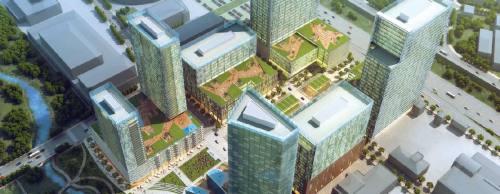One of the largest redevelopment efforts in downtown Austin history could help spur area health care improvements and create the anchor needed to establish the so-called Innovation Zone.
University Medical Center Brackenridge, built in phases beginning in 1970, will be torn down in 2017 and replaced that summer with a new teaching hospital across 15th Street called the Dell Seton Medical Center at The University of Texas. The facility’s demolition opens up 14.3 acres owned by Central Health, the public health entity created in 2004 to increase medical access for Travis County’s most vulnerable residents.
“The concept of having a big, public hospital downtown, which is increasingly difficult to get to and expensive to operate, is outmoded,” said Central Health board member Clarke Heidrick, who led a redevelopment subcommittee. “A lot of the patients we’re responsible for are spread out much farther away.”
The new teaching hospital, managed by Seton Healthcare Family on state-owned land subleased by Central Health, could provide a more modern approach to medicine, Heidrick said. Closing down Brackenridge, he said, also creates an opportunity to help realize the Innovation Zone concept first touted by former Mayor Lee Leffingwell in early 2014.
The proposal called for complementary development in eastern downtown to coincide with the new UT Dell Medical School, which opens in phases beginning in June. Innovation Zone efforts are now spearheaded by state Sen. Kirk Watson, D-Austin, who pitched a new teaching hospital and medical school in 2011 as part of his 10 Goals in 10 Years initiative.
“Even if we had not moved forward [with replacing Brackenridge], I think the community would’ve been engaged in a debate about what to do with the building, and it would be costing the taxpayers money,” Watson said.
 Balancing project benefits
Balancing project benefits
Any new uses on the Brackenridge property must not only be complementary to the adjacent UT Dell Medical School but also provide enough of a financial return for Central Health to fulfill its broader mission, Heidrick said. The Central Health board approved a redevelopment plan Jan. 27 and expect to solicit proposals beginning this spring, he said.
Once completed, the six-block Brackenridge campus could include 3.7 million square feet of developable space with buildings as high as 35 to 40 stories. The plan proposes residential, retail, office and hotel spaces in addition to any medical uses.
Central Health would lease the land to the master developer, Heidrick said, and fewer restrictions placed on the property’s uses could yield higher rent for off-site health care initiatives.
“I think we’re in a position of strength in that we are not bound by any fixed deadline,” Heidrick said. “We want to do it right and do it wisely, so we’re not going to enter into some deal that doesn’t make sense.”
Watson said he agrees Central Health should maximize its gains from the property to improve health care access to all residents. Ultimately, he said, any new development on the Brackenridge campus will catalyze other activity.
“This property could put us in competition with cities from Houston to Hong Kong and bring in the next phase of innovation—and not just health care innovation,” Watson said.
Much focus has been placed on improving the customer service and business side of medicine. Greg Hartman, Seton president of external affairs and network support services, said his hospital group was only able to convince its parent company, Ascension, on approving a new hospital building because of partnerships with Central Health and UT to create a new integrated care system.
“We have to blow the old system up and start all over,” Hartman said. “We want to be the lab for UT innovation to take place. We’re even telling UT we want to do things differently—just tell us how.”
Involving other key players
No new major U.S. medical school has opened in nearly 50 years, so officials can “rethink everything,” Watson said.
“Unlike other medical schools that have been there a while and are set in their ways, [UT] can create a new formula for how they educate the next generation of doctors,” he said.
Mini Kahlon, UT vice dean for strategy and partnerships, works with Watson on a task force to determine how the medical school can help spur an innovative district. The new campus will include classrooms, office space, specialized outpatient clinics and incubator space, yet there is an opportunity to go beyond those uses, she said.
“Some of that will absolutely happen, but we want to go deeper,” Kahlon said. “Our goal is to be different from what other cities have done. If we just built a string of doctor offices, we’d all be in serious trouble.”
Kahlon is tasked with working with the city’s life sciences industry and the Greater Austin Chamber of Commerce to develop a new innovation economy.
Among the 5,100 tech companies in Austin, about 200 specialize in life sciences, said Michele Skelding, the chamber’s vice president of global technology and innovation. Forty percent of those groups specialize only in medical devices, she said, so more diversity is needed within the field.
Without that diversity, the Innovation Zone risks not living up to its potential, she said.
“Looking at other innovative cities, the public sector has never been the only or necessarily the leading force,” she said. “There also has to be strong private-sector leaders willing to put money into the concept.”
A lot of private money has already poured into another adjacent project led by the Waller Creek Conservancy. Efforts to revitalize the urban waterway are advancing, according to CEO Peter Mullan.
The new spaces resulting from the creek revitalization project, including a revamped Waterloo Park, will complement the Innovation Zone, he said. Most of the creek’s flood plain will also be removed, potentially increasing redevelopment opportunities.
The exact uses on the Central Health-owned property will not be determined until a master developer is picked this year.
“So that’s the next big question,” Skelding said. “Who will win the bid?”




